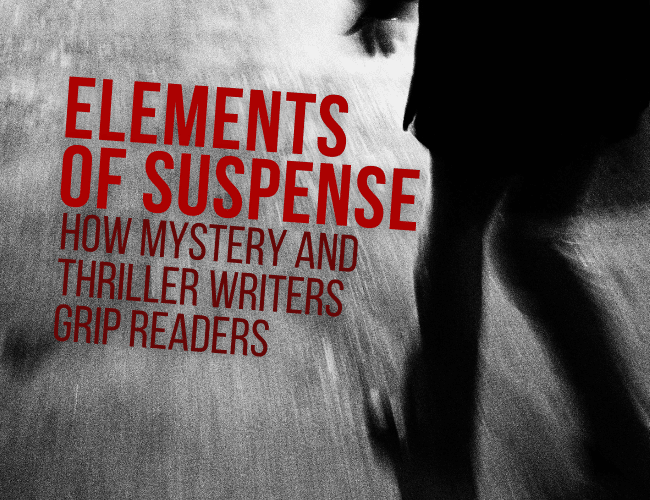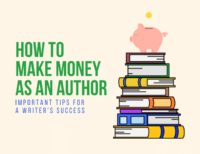Do you remember how you felt while reading The Da Vince Code or Gone Girl? The sweaty palms, the pleasant shiver, the jaw-clenching tension? Remember how those well-drawn elements of suspense held you in thrall, feathering along your skin, raising goosebumps?

Suspense fiction comes in a variety of flavors, all delicious, and if you have a yen for building suspense in your writing and learning how to create the same kind of reading experience for your own audience, this is the place for you.
In a special series of articles, I'll be your guide as we dig deep into the elements of suspense that grab readers and don't let go. These elements apply, regardless of the publishing route you choose for getting your stories out to your suspense readers.
Here, we will learn how you can craft suspense in your own books, starting now.
Anticipation…Worth the Wait
Anticipation is a critical part of suspense, and I suffered/enjoyed a long period of anticipation before I started my writing career.
With young children at home and a husband often away, serving on US Navy submarines, I waited until my baby graduated from high school and flew the nest. But my writing dream did not sit idle during those years.
I read just about every book on the craft of writing I could find, focusing my study on suspense fiction, and reveled in learning all I could. Most of all, I anticipated the season of my life when I would begin writing my own mystery novels, thrillers, and suspense stories.
At the time, I didn’t realize how critical this would be to my success. Understanding what grips readers in the thrall of mystery and thriller stories is key. And knowing how to enjoy a book for pleasure—to be a reader—is essential to being a good storyteller.
Learning From Story Masters
While working for our local library system, I attended an all-staff training day that changed my life.
Orson Scott Card was the keynote speaker and since I was part of the entertainment for the event, I shared the stage with him. I had visions of the two of us striking up a terrific rapport and him taking me under his wing as I prepared to enter the writer’s world.
None of that happened.
Mr. Card gave an excellent presentation on the power of words, but we never spoke beyond a hello.
However, in a breakout session after the main event, I had the great good fortune to meet the renowned writer and editor, Kristine Kathryn Rusch. She and her husband, the prolific author Dean Wesley Smith, have been my valued mentors for about the last ten years.
A good deal of what goes into my own work today sprang from the massive store of writerly wisdom they passed on to me, and it’s jumped my writing light years ahead, helping to make up for my late start.
I’m pleased to be able to share some of what I’ve learned from my years of preparation and experience with you!
Examining the Elements of Suspense (and Why This Matters)
What is suspense? What function does it serve and why is it so appealing to readers?
More importantly, how can you create it in your own work?
In this article and the ones to follow in the series, I will teach you the key elements of suspense.
Here’s some of what we’ll cover:
What is Suspense? Why and How It Makes Books Better
We’ll take a stab at a definition of suspense and look at some important distinctions between suspense as a necessary ingredient in every story and suspense as a popular genre category. With a little help from the master, Alfred Hitchcock, we’ll see how suspense is different from surprise and how they both function in a story.
We’ll also talk about the foundation you’ll need to build in order to use the elements of suspense to good effect in your own stories. For example, in order for readers to experience suspense in your stories, they need to be mindfully present and meaningfully invested.
You learn all of this and more in this article.
Deep POV: 6 Key Details to Use in the Beginning of Your Book
As part of the foundation you must lay for a suspense-filled tale, you'll need to grip and pull the reader deep into your story. There are many writing techniques you can use to accomplish this throughout your entire story.
For example, when you solidly ground the reader inside the head of the point of view character, filtering every word through that viewpoint, your readers will forget they're reading.
Grounding your reader deep in your protagonist's POV will do a world of good for the rising action in your story, building stakes and smaller conflict as they spiral into an intense, climatic moment. Silence of the Lambs is a great example of this, where as Clarice Starling grew closer to discovering the whereabouts and identity of Buffalo Bill, Hannibal Lector's masterful escape plan spiked.
Learn more about these techniques in this article.
Sympathetic Characters: 10 Writing Techniques That Make Readers Care
A writer can craft a scene full of exciting action and surprising revelations, but if they haven’t first engaged their reader in caring about the main character, it won’t matter.
Readers like strong characters, but also appreciate a hero that has flaws. Learn how character development, and how to make your reader invest in your protagonist in this article.
Raise the Stakes: The Ultimate Guide to Building Suspense in a Plot
Writers who know how to raise the high stakes in a story understand how to provide action that drives the story forward.
Action often brings impending danger, and is one of those “go-to” elements of suspense, but you’ll see that you don’t have to rely on a high-speed car chase or hand-to-hand combat to get suspense out of action.
Ensuring that there is tension between the characters in a scene, using active setting, and making sure the pacing matches the content are some of the methods you can use to create action that will generate a feeling of suspense.
Learn more about how to raise the stakes in this article.
Sequence of Events in a Story: How to Order Scenes That Build Suspense
How and when you impart information to your reader is a crucial factor in adding suspense to your stories. It’s all about giving your reader what they need and when they need it, so they'll keep reading and stay deeply involved and actively participating in the story.
Learn more about how to write a story with a strong sequence of events in this article.
Cliffhanger Meaning 101: What They Are and How Writers Use Them
Cliffhangers hark back to anticipation, like that old ketchup commercial—you know it’s coming, and you know it’s going to be good, and your hunger and eagerness grow as you wait for it to happen. The art is in the timing.
You want to know where to cut the scene for maximum effect, and how to build the anticipation without letting those french fries grow cold.
There are a number of cliffhanger techniques that deserve attention, and we’ll take a good look at several and learn how to craft them. Realizing that without the foundational setting of the stage these cliffhangers will lose some of their impact, I'll share some examples of suspense from writers like Dennis Lehane and Stephen King.
Read all about cliffhangers and how to write them in your suspense story here.
Story Pacing: 4 Techniques That Help Manage Your Plot's Timeline
Pacing is perhaps the most advanced of the elements of suspense. It makes sure that the reader feels invested in a plot and character.
One of the guiding principles of pacing is making sure that your form follows content, creating a compelling congruency that will keep your reader plunging forward, immersed in a story.
What do I mean by form following content? Ask yourself what's happening in your story.
Examine how the masters provide strong story pacing in their suspense books by using the techniques I mention in this article.
How to Write Action Scenes That Add Suspense to a Story
In the years after your reader has finished your book, they may not remember every plot point, but they will remember how they felt while immersed in your story.
Part of this thrilling emotions come from action scenes—but moving your story into an action sequence can be a risky business. It requires special attention, and if you don't give it what it needs, you invite your reader to leave the book.
In this article, I teach three obstacles writers face when writing action scenes, and how to overcome them.
Foreshadowing: 10 Clever Methods to Write An Engaging Plot Twist
Foreshadowing is the weaving of hints into your story so that future events feel natural and inevitable instead of contrived. It also allows the reader to predict and anticipate those events, adding suspense.
The addition of situational irony can also heighten the suspense of any story.This is when you put the reader wise to something your protagonist doesn't know, thereby letting them sweat for the unaware hero.
Seasoned writers use literary devices to weave suspense throughout their stories. You can learn ten methods on how to do this in your stories in this article.
Mystery Clues: The Ultimate Guide to Clues and Red Herrings
Red herrings, or false clues, are essential in suspense stories, mysteries, and thrillers. This misleading trail will keep readers guessing, and simultaneously keep them invested and excited in finding out what happens next.
Mastermind red herrings, however, isn't always easy.
You can learn more about the importance of mystery clues, and how to plant red herrings and turn clues in your book in this article.
Subtext Examples: 7 Techniques to Supercharge Your Scenes
Have you ever read Hemingway’s story, “Hills Like White Elephants?” Dripping with subtext, it masterfully raises questions and builds suspense.
You can learn to do that, too.
Using subtext lets you add nuance to a scene by giving it an underlying meaning implied by the surface action and dialogue. A striking example comes from an early scene in the Billy Wilder movie, Double Indemnity, based on a James M. Cain story. The two principle characters speak of cars and speed limits as euphemisms to cover their budding interest in each other.
You can learn all about subtext and how it adds suspense to your stories in this article.
Atmosphere Literary Definition: Genre Examples That Evoke Emotion
Atmosphere is the texture of the story, created by the careful selection of details, that provides the sensory palette through which the reader will experience story events.
Atmosphere matters. But how do you use atmosphere in your book?
Learning the literary definition of atmosphere (with genre examples) can help you write a better book, all of which I teach in this article.
Euphonics: How Sounds and Words Engage Readers
Euphonics deal with the sounds of the words you use, their rhythm and resonance. For example, words riffing on the letter F tend to bring to mind the flighty and frivolous, things that are fluffy, ruffly, flirtatious, and so on.
Using these words imparts a certain feel to the writing. You can use other phonetic sounds to produce a variety of euphonic effects.
There's a reason suspense starts with S.
These techniques are enhancers, like the seasoning that brings out the best flavors in a well-prepared meal. Judicially sprinkled, they can boost the level of suspense in a well-told story.
Learn more about how to use euphonics to spice up your story in this article.
Genre Expectations to Satisfy Your Reader
Readers are drawn to the suspense genres—mysteries, thrillers, and suspense—because that’s the flavor they crave. When you sit down to write such a book, you're making big promises to your reader—and you'd better follow through.
Readers want a certain type of reading experience, and my target readers have learned they can find it in the pages of a well-written mystery, thriller, or suspense novel.
It’s my job, as a writer, to make sure they get what they came for, and you’ll want to do the same for your readers. Deliver on your reader expectations and you'll win a fan for life.
One way to make this happen is to give them what they expect, but not in the way they expected it. For instance, readers of detective fiction expect there will be a scene toward the end of the book when the detective explains how he reached the solution.
When you write a detective mystery, you must somehow include this scene. It's indispensable, if you want to please your reader.
We'll also take a look at some of the other expectations reader have, like the introduction of the crime scene and the final confrontation between hero and villain. Read more about it in this article.
Building a Team to Satisfy Your Reader
One particularly pleasing aspect of most well-loved stories is the team.
While it’s not usually marked out and blatantly labeled as a team, most popular protagonists surround themselves with a support structure. The members of that structure serve important functions and provide points of interest for the reader.
For example, if you're a fan of the TV show NCIS, you're well acquainted with Gibbs's crack team of crime solvers. James Patterson has created for his character, Alex Cross, a team of colleagues and family members that his readers adore.
In an upcoming article, we’ll learn how to build a team to help drive the story, deliver pertinent information, and populate the type of secondary plotlines that add dimension and support the main storyline.
Strengthening Your Story Idea
Every story has been written before, but you might be able to tweak and twist your story idea into something fresh and compelling.
For example, you could change up the genre, like the writers of Throw Mama from The Train did when they vamped on the Alfred Hitchcock film, Strangers on a Train, turning the thriller classic into a comedy.
We’ll look at a variety of methods you might use to innovate your idea for a mystery or thriller novel or short story in a new article soon.
Plotting for Suspense
After studying the elements of suspense and learning how to use them in crafting a suspenseful story, we’ll focus on plotting, creating the underlying structure that will support and give shape to the story.
Understanding the elements of suspense will help you construct a plot optimized for suspense.
Plot diagrams are a good way to study these elements in plotting and structure. A favorite of mine, and the one I use in conjunction with Scrivener to write each scene of my novels, is what Shawn Coyne calls The Five Commandments of Storytelling.
Another structure similar to this one is the Six Elements of Plot, which Joe Bunting covers in his book The Write Structure.
We'll take a closer look at this structure and examine some of the other plot diagrams best suited for the suspense genres, like the Lester Dent Seven-Point plot structure and the Brooks model.
Check it out and learn more in this article on story structuring for suspense.
The End…Now What?
At some point—after the writing, polishing, and proofreading—it will be time to package your work and release it into the world. But where will you send it? What exactly have you created, anyway?
Your book will appeal to a certain set of readers.
The trick is to make sure they can find it. If you market it incorrectly, placing it on the wrong “shelf,” no one will buy it and those who do probably won’t like it. You need to make sure it shows up where the readers who will like it shop for books.
We'll examine a series of questions you can apply to your book to help determine genre and sub-genre. A lot of this depends on how much weight you've given each of these five story elements: character, setting, plot, voice, and style.
And we’ll look at additional paths you can use to figure out what you’ve written and how to reach those who will appreciate it. Stay tuned for a future article on these essentials!
Get Empowered by Becoming Knowledgeable, Then Write!
The reason I write, the driving force behind my continuing efforts, is my desire to create for readers of suspense what other writers have done for me. I want to bring that gift, that same kind of thrill and zest, to someone, somewhere, curled up with one of my books.
If you have that same kind of desire, stick with me through this series of articles. We’ll dive into the elements of suspense, examine them, learn how to craft them, and discover how to go deeper and learn more.
Bookmark this spot. Watch for the upcoming articles, read them, put them into practice, and get empowered!
You can learn how to write a gripping mystery or thriller that readers will love.
Until then, I hope this introduction to the elements of suspense has got your wheels turning. Take that story idea that's been harvesting in your head, and let it loose.
How about you? Are you excited to learn more about the elements of suspense? Tell us about it in the comments.
PRACTICE
In this series, I'll challenge you to build your own suspenseful mystery or thriller story as you learn.
Today, take fifteen minutes to write a premise for a mystery or thriller book that will apply elements of suspense. Describe the story in one to two sentences (and if you're feeling inspired, turn those sentences into a paragraph or two of synopsis!).
As we work our way through the series, keep that idea on hand—we'll be building it into a book as we go!
When you're done, share your idea in the Pro Practice Workshop. Be sure to provide feedback for your fellow writers!







0 Comments